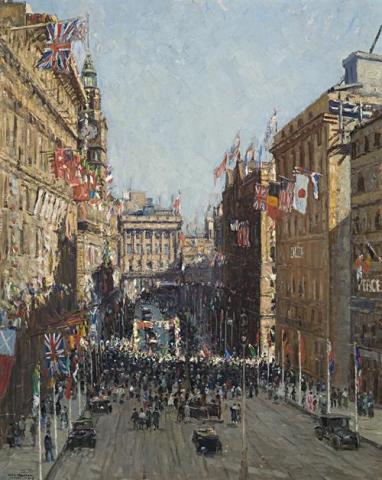VICTORY CELEBRATION, MARTIN PLACE, SYDNEY, 1919
Will Ashton
oil on canvas
76.5 x 61.0 cm
signed and dated lower left: WILL ASHTON / SYDNEY 1919
Joseph Brown Gallery, Melbourne
The Estate of Pro Hart, Broken Hill, New South Wales
Spring Exhibition, Joseph Brown Gallery, Melbourne, 7 – 23 October, 1974, cat. 33 (illus. in exhibition catalogue)
The Great War did not end officially until June 1919 with the signing of the Treaty of Versailles. The 19th day of July 1919, as proudly recorded by The Sydney Morning Herald, was 'set apart for the celebration of peace throughout the Empire.'1 Although winter in Australia, nature joined the historic celebrations- 'When Saturday morning broke in a flood of golden sunshine every road led eager feet to the city'. 'The decorations' our enthusiastic reporter continued, 'were far-reaching, lavish, and in places superb'.
From sparkling light to crowds and bunting, Will Ashton's Victory Celebration, Martin Place, Sydney, 1919, looking down Martin Place towards George Street, captured the scene and the mood to perfection. Set a little back from the actual march itself, Ashton embraced the whole scene, giving emphasis, by the fall of light, to the throng of marching soldiers and sailors, crowds, and a triumphal arch of flags and pennants cleverly highlighted against the more shaded background. His skilful use of empty foreground and carefully devised perspective draws the viewer into the picture to join with the crowds cheering the troops as they 'swung past in thousands'. With pride they acknowledged these 'spirited boys, who have made the name of Australia famous throughout the world.' The peace march moved along Macquarie, Bridge, George, Elizabeth and Park streets, each 'gay with rainbow colours, and nearly every big building carried a legend or device symbolic of the day.' The word 'PEACE' lettered in white is seen clearly to the right in Ashton's painting. At 11.30 am the bells fell silent as all stopped in honour of the fallen. The only battle fought that day was with confetti, carpeting Martin Place and streets around.
Three times winner of the Wynne Prize for landscape painting, Ashton is best known for his handling of the play of light in Australian paintings and scenes along the River Seine, its boats, bridges and surrounding buildings. He captured them in the same impressionist manner as in this painting, blending the academic with that tangible feeling of immediacy that comes from painting outdoors. This image of crowds, flags, and Sydney City recalls other paintings close in time such as Grace Cossington Smith's Reinforcements: Troops Marching, c.1917, in the collection of the Art Gallery of New South Wales. Ashton, however, takes the more distant view, the subject being the overall scene of streets, buildings and bunting. While distantly reminiscent of the nineteenth-century Parisian street scenes of Impressionists such as Camille Pissarro and his Boulevard Montmartre, 1897, in the National Gallery of Victoria, it is the memorable, historic scene, that appealed most to Ashton.
1. Sydney Morning Herald, 'Historic Day in Sydney', 21 July 1919, p. 9
DAVID THOMAS
